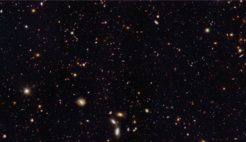Population explosion in dwarf galaxies
Unusually productive dwarf galaxies pose a riddle, but simultaneously appear to solve the riddle of the unusual distribution of Dark Matter
In the early universe, small, young galaxies produced new stars at an extraordinary rate. For current models of galaxy formation, this high star production rate is difficult to explain. And yet such active dwarf galaxies are reality: a team of astronomers led by Arjen van der Wel of the Max Planck Institute for Astronomy (MPIA) in Heidelberg was able to observe them with the Hubble telescope.

Dwarf galaxies, with masses around one hundredth of the mass of our home galaxy, the Milky Way, are the most common type of galaxy in the cosmos, and their study can reveal important clues about galaxy formation in general. When it comes to celestial objects, distant dwarf galaxies are rather faint and small, and thus hard to detect. Up until now, very few examples were known, the result of dedicated telescope observations focusing on small patches of the sky. This has now changed – thanks to the CANDELS survey, the largest project in the history of the Hubble Space Telescope. Over three years of observations (2010-2013), CANDELS is set to examine the most distant galaxies in the universe.
When it came to dwarf galaxies, the astronomers were in for a surprise: "We found a population of 69 dwarf galaxies that stood out because of their unusual colours," says Arjen van der Wel (MPIA), the lead author of the new study. Due to their great distance, astronomers see these dwarf galaxies as they were nearly 10 billion years ago.
As subsequent studies of the spectra of four of these galaxies confirmed, the unusual colour of these objects is due to the fact that they are producing new stars at a surprisingly high rate. At this rate, it would take such a galaxy only about 15 million years to double the number of stars; in contrast, it would take our Milky Way galaxy 1000 times as long.
The astronomers appear to found a key piece of the puzzle of galaxy evolution. MPIA director Hans-Walter Rix explains: "Through 'archaeological' studies of nearby dwarf galaxies, carefully tracing stellar ages, astronomers already knew that most of those galaxies' stars formed more than 8 billion years ago. What they didn't know was whether star formation proceeded slowly or quickly. The new results indicate that stars are likely to have formed quickly, with each galaxy undergoing but a few periods of rapid star formation."
While some simulations of dwarf galaxy evolution show episodic bursts of star formation, none of those are intense enough to explain the observed very high formation rate.
Whereas these dwarf galaxies' high star-formation rate constitutes itself a cosmic riddle, it could help to clear up another, more long-standing mystery concerning something invisible: so-called Dark Matter which accounts for more than 80% of matter in the universe and which reacts with other matter only via gravitation, and in particular emits no light. Dark Matter plays a key role in the way that, over the 13.7 or so billion years of cosmic evolution, an initially fairly homogeneous universe condensed to form today's variety of galaxies and galaxy clusters.
But conventional simulations of galaxy evolution give a result that is at odds with observations: It predicts that dark matter should be concentrated significantly towards the center of a galaxy ("cusp profile"). Observations, on the other hand, have shown a much more even distribution of Dark Matter. As early as 1996, astronomers (Navarro et al.) had surmised that this distribution could have evolved as ordinary matter was blown outwards from the galaxy, pulling some of the Dark Matter along. But how?
The newly discovered intense bursts of star-formation activity in dwarf galaxies could provide an answer – because in processes such as these, gas within the galaxies would truly have been blown outwards, which would explain the unusual distribution of Dark Matter.
MP/HOR
